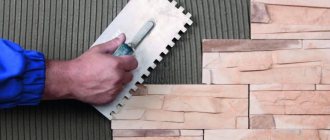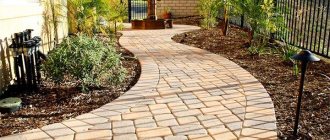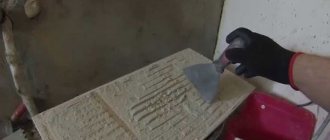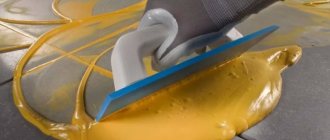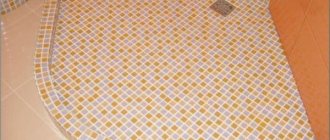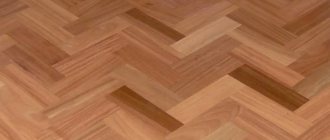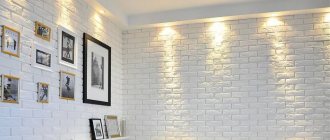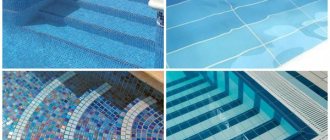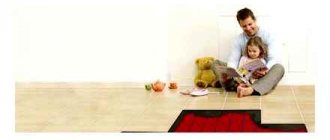Reasons for use
First, the glue is applied to the tile or wall with a regular spatula, and then the excess is removed with a comb. This allows you to leave a certain amount of glue on the surface, which will be evenly distributed. After pressing the tile, the glue will be evenly distributed and fill the entire space. It is quite reliable enough to avoid getting holes when the pan falls, but the enamel will most likely get chipped.
This achieves:
- Quality of installation. Since the layer of glue will be the same, the tile will automatically lie flat (if you have a flat base).
- Speed of work. There will be no need to squeeze out or remove excess glue.
- Connection strength. If there is an excess, it gets worse.
- Economical. The amount of glue recommended by the manufacturer will be applied, and there will be no need to overpay for overuse.
It is more convenient to work with a toothed comb with a handle in which two sides are serrated and the other two are smooth. You don't have to constantly change between a regular spatula and a serrated one.
Tooth shape
- To apply ridges from 6 to 10-12 mm, standard square teeth are used.
- For ridges over 12 mm when working with cement mounting mixtures, semicircular teeth are used. At this thickness, the track combs more evenly and does not fall off if it has a semicircle in cross-section rather than a square. They are also used for applying synthetic adhesives with strong spreadability, regardless of the layer thickness.
- There are also sometimes combs with triangular teeth. They are not suitable for laying tiles; they are used for applying elastic adhesive in a thin layer (up to 4 mm) for PVC tiles.
Depending on the shape of the teeth, the spatula may be marked with letters and numbers. The number indicates a group of size parameters, and the letter indicates the shape:
- A – triangular teeth, without large spaces between them;
- B – triangular with large intervals;
- S – triangular without gaps;
- C – square;
- R – rectangular (including irregular shape);
- M – semicircular.
Tooth sizes
The thickness of the applied glue can be adjusted by changing the angle of inclination. Also keep in mind that after pressing the tiles, the glue will distribute into the voids and settle.
The adhesive layer flattens out after pressing.
Approximate sizes of teeth depending on the area of the tile:
Tile area, cm2 Teeth size, mm Adhesive layer after pressing when applied at an angle of 45°, mm Adhesive layer after pressing when applied at an angle of 60°, mm
| 2500 | 12 | 4,2 | 5,2 |
For a floor or uneven base, the size of the teeth is selected larger.
Which comb should I use to lay tiles?
A comb is needed for uniform and economical application of glue to the surface. Without a notched trowel, it will not be possible to lay ceramic tiles or any other product efficiently. Speeds up the process of laying tiles. Differs in the following parameters:
- Material of manufacture
- Tooth shape
- Tooth size
- Comb shape
Comb material
- Metal (steel) spatula with a protective layer against corrosion. The advantages of a metal spatula with a protective layer are its strength and low cost. The disadvantages include a short service life. The protective layer wears off over time, and the spatula quickly begins to rust and becomes unusable.
- Stainless steel comb . The main advantage of a stainless steel comb is its durability. If we exclude mechanical breakdowns, then such a spatula is almost eternal. drawback : the high price of a notched trowel.
- Plastic comb . A plastic comb is suitable as a disposable option, as it is very fragile. But in defense of the plastic spatula, we can say that it is perfect for installing fragile products.
Comb tooth shape
The shape and height of the teeth are selected depending on the size of the tile, the composition of the adhesive, and the condition of the surface under the tile. The notched trowel is classified by letters and numbers . The letter means the shape of the teeth, the number means the size of the teeth.
- A. _ Marking A can have a digital gradation from 1 to 5. The shape of the teeth is triangular, the distance between them is small. It is considered a universal spatula and can be used for most jobs.
- IN . The teeth are also triangular in shape, only the distance between the teeth is larger. Graduation from 1 to 17, except for number 4. Due to the increased gap, a larger layer of glue can be applied. Convenient to work with mobile mixtures.
- WITH . A spatula with a C means the teeth are square. Gradation 1 - 5. Designed for tiles.
- S. _ The teeth are triangular, without gaps, reminiscent of a hacksaw for wood. Used for laying PVC tiles. Graduated from 1 to 4.
- R. _ Rectangular teeth of varying heights. Used for laying tiles on a non-uniform surface, the shape of the teeth allows you to apply more glue. The numbers go from 1 to 4.
- M. _ The semicircular shape of the teeth allows you to work with concrete or synthetic substrates. Also when a ridge height of more than 12 mm is required.
Recently, you can find serrated trowels with an oblique tooth, with a combination of teeth of different heights. This allows you to more tightly fill the space between the base and the tile.
Tile comb tooth size
Table for selecting a comb for tiles and conditional adhesive consumption.
The size of the teeth is as important as their shape. Not only the glue consumption, but also the quality of the entire work depends on the size of the teeth.
For which tiles which comb?
- If you need to apply a very thin layer of glue, use a spatula with a tooth height of 0.6 - 1.2 mm .
- If we are talking about mosaic , a trowel with 3 mm teeth .
- As a rule, for tiles up to 15 x 15 cm, a trowel with a 4 mm .
- For small tiles, such as 20 x 20 cm , for example, use a comb with a 6 mm .
- For large-format tiles, a comb with a tooth size of 8 mm .
- A notched trowel with a tooth of 10 mm or more is used for thick (about 10 mm) tiles and large tiles.
Comb shape
The tile comb differs in the shape and location of the handle.
- Trapezoidal comb. The handle is located on the side, in the same plane with the working surface. The advantage of such a comb is that it is convenient to remove excess glue from the base without applying much force with your hand. The disadvantages are the small area of the spatula; this forces you to remove excess glue from the comb each time, which affects performance.
- Rectangular comb with a perpendicular handle.
The advantages of a rectangular comb are its versatility . It has two sides with teeth and two sides that are smooth. The teeth on each side can be of different heights and shapes to work with different tiles; the smooth sides are intended for applying the adhesive mixture. Essentially, this is a 2 in 1 tool . The disadvantages of a rectangular comb are its weight. Without proper dexterity and experience, your hand get tired quite quickly . Which again will affect performance.
It is impossible to say which comb shape is better, because it all depends on the anatomy of your hand. Before buying, imitate the work with a spatula, feel it. Choose based on your own feelings .
Rules for applying glue
When working with a notched trowel, it is important to understand how the adhesive will behave so that there are no voids left under the tiles.
An important rule: you need to apply straight parallel grooves with a spatula; you cannot make turns with it, as they will create voids.
The glue should be applied with a spatula at an angle of approximately 60 degrees to the base. Most often it is applied specifically to the base, but some do it separately for each tile, which reduces the speed of work.
Apply the glue with a smooth spatula at an angle of 30 degrees, and then go over it with a comb at an angle of 45-75 degrees.
Another method that some craftsmen use to increase adhesion is to lay the tiles “scrape”. This means that first, glue is applied to the base under the comb. Then glue is applied to the tile itself with an ordinary spatula, and then it is torn off. The remaining 1-2 mm of glue acts as a primer.
To ensure that the glue comes out from under the tiles less and the seams remain clean, some craftsmen file off the outermost tooth at the comb.
What does one cut tooth give?
Base requirements
If you want to get a result that complies with current standards (and this is worth striving for), then you need to have an appropriate basis. So, let's consider what maximum deviations in laying tiles indoors are allowed by SP 71.13330.2017 (Updated edition of SNiP 3.04.01-87):
Walls: • Deviation from the vertical is no more than 1.5 mm. by 1 m, but not more than 4 mm. to the floor. •Deviation of seams horizontally and vertically is no more than 1.5 mm. per 1 meter of seam. •Plane irregularities when checking with the two-meter rule (clearance) are no more than 2 mm. •Seam width deviation ±0.5mm
Floor: •Plane deviations no more than 1 mm. on the two-meter rule. • Deviation from a given slope (slope from the horizon, by default) is no more than 0.2% (2 mm/1 m), but not more than 10 mm.
Therefore, the base must be no worse than the requirement for the lined surface. It’s even more like this: the base should be as perfect as the tiler can level it. A beginner should not hope to correct some errors with the help of cladding - most likely, irregularities will only increase.
Yes, the base must be perfect, so the tiler must be able to plaster. There is an unspoken rule that the master prepares the base for laying the tiles himself - then you certainly won’t be able to blame someone else for poor quality work.
Purpose of a notched trowel when laying tiles
A notched trowel evenly distributes the elastic adhesive over the surface and ensures economical consumption of the applied adhesive material. Hand tools are required to adjust the thickness of the tiles. Thanks to it, the speed of the master’s work increases several times. This effect cannot be achieved if the work is carried out with an ordinary scraper with a flat metal plate.
A selection of tile comb manufacturers
Below are the most popular manufacturers of notched spatulas.
Russia
- Polytech. Russian company - manufacturer. Among other things, also hand tools.
- Sibrtech . Siberian Technologies presents more than 5,000 types of hand-finishing tools.
- Bison Probably one of the most popular manufacturers on the Russian market.
Europe
- Forbo. Association of companies from Germany, Sweden and Switzerland. They work on flooring, as well as hand tools.
- COLOR EXPERT. The homeland of the brand is Germany. They produce professional hand tools. The company is confident that there is a professional in everyone, the main thing is to work with a quality tool!
- Hardy. The country of origin is Poland. They produce professional hand and painting tools at affordable prices.
- STANLEY. Not exactly a European manufacturer, but it was impossible not to mention! American company producing professional hand tools.
Type of combs
There is no universal tool for facing work. The notched trowel has triangular, square, rectangular and semicircular edges. Its width should match the tile or be larger than its size. This will provide the tiler with comfortable working conditions. The scraper is selected according to the thickness and area of the finishing material.
To cover the surface with a thin layer of adhesive, a comb with small triangular teeth 0.6 or 1.2 mm wide, with a small distance between them, is suitable.
A triangular scraper with large tooth spacing of 4 mm is convenient for laying mosaics and even tiles with an area of up to 100*100 mm, with an adhesive consumption of more than a kilogram per square meter. A smooth surface allows you to use less adhesive mass than a porous structure.
To lay tiles measuring 100*100, 150*200, 200*200 mm with an uneven surface, it is practical to choose a notched trowel with edges 6 mm thick. The volume of glue varies from one and a half to three kilograms per square meter.
Finishing work with 300*300 mm tiles requires a hand-held square tool with 8 mm teeth. The volume of glue applied reaches four and a half kilograms per square meter.
To lay large format tiles or 10 mm thick, it is advisable to use a large scraper with 10 mm square teeth or a 12.5 * 20 mm tool. The amount of material consumed will reach six kilograms per square meter.
For hollow-free installation of horizontal slabs, a semi-liquid adhesive solution and a 15*20 mm toothed comb are used.
What do glue manufacturers recommend?
In addition to the recommendations of professional builders, it is also worth listening to the words of tile adhesive manufacturers. After all, they are the ones who know well what the tool should be like in order to leave behind the optimal thickness of the adhesive mixture. If the comb is selected perfectly, the adhesion strength of the tile to the wall will be maximum. Therefore, on packages of construction adhesive, manufacturers often indicate a table corresponding to the size of the tile and the thickness of the teeth on the spatula:
| Comb tooth length | Minimum tile size | Maximum tile size |
| 3 mm | 50 mm | 70 mm |
| 4 mm | 70 mm | 100 mm |
| 6 mm | 100 mm | 200 mm |
| 8 mm | 200 mm | 300 mm |
| 10 mm | 300 mm | 500 mm |
| 12.5 mm | 500 mm or more | |
If the teeth on the spatula are too small, there will be insufficient amount of glue on the tile - it will not adhere well and will come off over time. Too large teeth guarantee huge waste on repairs and peeling off the tiles (the glue will not hold the heavy mass of the tiles).
Spatula with teeth of various sizes
Different types of glue have different compositions, therefore, the shrinkage coefficient and setting time will not be the same. In order for the repair work to be carried out to the highest possible quality, it is recommended to deviate from the average parameters indicated in the table above and follow the indicators characteristic of a particular brand of glue:
| Ceresit CM11 Plus | |
| Maximum tile size | Maximum tine height |
| 5 cm | 3 mm |
| 10 cm | 4 mm |
| 15 cm | 6 mm |
| 25 cm | 8 mm |
| 30 cm | 10 mm |
| Ceresit CM14 Extra | |
| Maximum tile size | Maximum tine height |
| 15 cm | 6 mm |
| 25 cm | 8 mm |
| 30 cm | 10 mm |
| 45 cm | 12 mm |
| Ceresit CM12 | |
| Maximum tile size | Maximum tine height |
| 30 cm | 10 mm |
| 60 cm | 12 mm |
| Ceresit CM17 | |
| Maximum tile size | Maximum tine height |
| 10 cm | 4 mm |
| 15 cm | 6 mm |
| 25 cm | 8 mm |
| 30 cm | 10 mm |
| 45 cm | 12 mm |
One last tip: be sure to follow the manufacturer's recommendations when diluting the adhesive in a bucket. Even with a slight violation of the proportions, the characteristics of the adhesive may be lost. It is not recommended to use a substance whose expiration date has already expired (usually glue is stored for 3-4 days after dilution).
Basic rules for choosing a notched trowel
When buying a hand tool, you need to pay attention not only to the shape, but also to the size of the teeth. Experts in facing work give some practical tips that may be useful to a novice master.
Determine whether it is convenient to work with such a tool. To do this, you need to pick up the device and imitate several professional movements typical for laying tiles. It is important to make sure that the handle is comfortable, strong, non-slip and securely fixed. It would be good if it was varnished. A special coating will eliminate possible scratches or splinters.
Large products are chosen with a light plastic handle, which will protect your hands from excessive fatigue.
Sometimes it is difficult to choose between flexible and rigid products. You need to choose the best option, since some models can quickly break down, while others will not give the expected result.
When choosing a tool, the volume of installation operations is taken into account. For small areas, a spatula of the same size is needed; for large products, a wide comb is selected; for laying small mosaic tiles, a medium option is suitable.
A high-quality styling comb is made of stainless steel. It has good performance characteristics. Modern models are made with a special coating, so it is practical to purchase several spatulas for work.
Type of tile: is it so important to consider?
Before laying tiles on an uneven floor, you should think about their choice. Spending a lot of time so that the first cracks appear in a couple of months is a dubious benefit.
First of all, you need to make sure that the tiles are intended for the floor! This material by default has sufficient strength and thickness, and also has good abrasion resistance. Tiles of this kind will retain their aesthetic and practical qualities for a very long time.
It is necessary to glue only the option that is suitable for the intended operating conditions. In particular, you need to choose the right product. Floor tiles can be:
- antibacterial;
- frost-resistant;
- with increased wear resistance;
- with a sliding surface.
All characteristics are indicated on the box. The tile must be certified - this is the key to the quality of the product and, accordingly, allows you to expect a long service life of the product.
Size doesn't matter, but gluing large slabs is much easier. The thickness of the tiles is important - the thicker it is, the stronger and more reliable the floor will be.
It is especially important to take these details into account if you plan to glue ceramics in the kitchen - one of the busiest rooms in the house. It is here that the most stringent requirements for strength, wear resistance and aesthetics are put forward to the quality of the coating.
Additional recommendations
Price is not always an indicator of the quality of a product. Two identical-looking combs may differ in cost and have different technical data. It is important to consider that as a result of intensive work, the teeth first fail, as they wear out and lose height. It happens that the cheap option is more profitable in practice.
You can choose the right tool using a simple experiment. To do this, apply an adhesive solution to the back of the tile with a spatula. The facing material is laid on the surface using a rubber mallet. If the adhesive does not reach or leave the edge of the seam, the spatula size is correct. The glue should evenly cover the installed cladding base. Modern packaging of adhesive compositions contain recommendations to consumers on how to use this or that device.
What if you lay tiles without a comb?
In order for the tile or porcelain tile to hold firmly, it is important to evenly distribute the solution over the surface. Due to large voids, the slabs will peel off. And if a warm floor is installed under them, it can overheat and fail.
Using only a regular spatula, it is difficult to achieve an even application, especially on an uneven surface. Hidden air voids may occur.
If you apply glue in a thick layer, it will be difficult to remove the excess. When pressing and tapping, a lot of mixture will come out. If adjacent tiles do not adhere, the edges rise. The result is noticeable differences in the level of the wall or floor.
Laying tiles without a comb increases the mixture consumption. At the same time, a layer that is too thick impairs the strength of the fastening.
Tool preparation
To lay tiles you will need not only a toothed comb, but also several available tools:
- at the preparatory stage - hammer, chisel, wire brush, terry brush;
- when priming - a roller or paint brush, a square, a building level, markings;
- for applying glue - a trowel, a rubber mallet, a ruler, a glass marker, a tape measure, a tile cutter or a special cutting machine;
- when finishing and cleaning seams - a grater, a foam sponge, a rubber spatula.
Before using glue, it must be diluted in a plastic container. The basic rule when working with a toothed scraper is that the glue is applied in straight lines, without curls. This will avoid the formation of voids. The choice of adhesive base depends on the operating conditions of the tile. The adhesive mass is intended:
- for heated floors;
- for deformable surfaces and gypsum fiber sheets;
- The basic design is a conventional DSP screed.
Laying stages
Installation work involves the following procedure:
- The tool must be held at an angle of 45–70 0. For even installation, it is important to maintain the same angle.
- The solution is distributed on the wall surface to be treated or on each tile separately. It is advisable to use one method, not alternate.
- The facing material is pressed to the base.
- To ensure that the glue is evenly distributed over the surface, lightly hit the tiles with a mallet.
- To save glue and create clean seams, some specialists remove the outer teeth from the tool.
- Many craftsmen lay tiles using the “scraping” method. It is applicable in particularly important areas. To do this, apply a little glue to the tile with a tool and distribute it over the entire area. Excess is removed with a spatula perpendicular to the surface.
- The adhesive mass is removed from the front surface immediately. The seams are being cleaned.
- It is advisable to do grouting no earlier than after 5–7 days.
- After installation, the comb for laying the facing material must be immediately cleaned of glue for further use. To make it easier to clean the tool, place it in a container of water while working.
- Walking on floor tiles is allowed only after 24 hours.
Related video: Comb for laying tiles on the floor
Which comb to lay tiles: types and differences
Those who are new to tiling work, especially when it comes to ceramic materials, often have questions about which trowel to use for laying tiles. After all, in reality there are quite a lot of them. And let some people think that laying tiles on a continuous layer of adhesive is of better quality, but in the meantime we will consider the choice of tool, and we will do everything correctly, observing reasonable savings on tile adhesive.
Grouting joints
Before starting, you should thoroughly clean the work surface. Remember the rule: grouting should not be done over the entire surface at once, but in parts. The facing material and tools should be periodically moistened, and the mixture should be pressed into the openings between the tiles. After jointing is completed, the surface must be cleaned of traces of the mixture.
Which putty is better to joint the seams of paving slabs? Outdoor pavement is susceptible to moisture and temperature fluctuations, so the choice of composition should be approached taking these features into account. Stores sell a special fugue for exterior work, however, you can make it yourself from cement putty and primer. The mixture for laying paving slabs must be diluted to the state of liquid sour cream. Then a durable plastic bag (you can take it from a milk bag) is filled with a fugue and grouted.
Why do you need a special spatula?
First, let's figure out why you need a comb for laying tiles. Everything is quite simple here. When applying the adhesive mixture, it is leveled with a notched trowel, resulting in grooves being formed. They also determine the uniform distribution of the adhesive mixture over the surface of the tile.
Due to this we get the following advantages:
- High quality styling. This is due to the distribution of the adhesive mixture in an even layer over the entire area of the tile. Accordingly, the material itself will lie as smoothly as possible, of course, if the base is previously prepared and leveled.
- This approach also increases the speed of work, since in this case you do not have to press the tiles in and remove excess glue every time.
- The strength of the connection is ensured. In the case of a lack or excess of glue, on the contrary, it decreases, and using a tile spatula helps to apply exactly the required amount of the mixture.
- And the last thing is cost-effectiveness, since the spatula will help eliminate waste of material by applying exactly the required amount.
A little advice on which tile trowel to choose. It is most convenient to work with a tool that has two serrated sides, while the other two are smooth, which allows you to do all the work with one tool, without constantly changing one to the other.
General views
Notched trowels are useful in the process of laying tiles, as well as for obtaining a smooth surface, and even a level is not needed; they are convenient for applying an even layer of adhesive to the surfaces to be glued.
Read also: Why do fighters stuff their fists?
Obviously, the adhesive solution is first applied using a regular spatula and leveled using a “comb”, so it is necessary to use two spatulas.
To lay tiles better, you need to use a “comb” with the correct teeth:
Characteristics when choosing a comb
Different types of combs can be determined by the shape of the teeth, since it differs in different cases, and here it is important to know which trowel is needed for laying tiles.
Tooth shape
The difference in shape is due directly to the thickness of the layer, and differs as follows:
- When laying tiles on a layer of adhesive from 6 to 12 millimeters, square-tooth combs are used.
- For larger layers, over 12 millimeters, tools with semicircular teeth are used. Because when using square ones, the path is difficult to comb, and in addition, the furrows fall off. In the case of a round shape, this is not observed.
- Also, sometimes there are spatulas with triangular teeth; these are used when laying tiles on a layer of up to 5 mm, in particular for PVC tiles.
Like any other tool, spatulas also have their own markings, which indicate the size and shape of the teeth. It is written in a combination of letters and numbers. Examples of markings are shown in the table below:
And now a little about decoding:
- Small triangular teeth with small intervals are marked with the letter - A.
- Tool with large spaces between triangles - B.
- With no spaces - S.
- With square teeth – C.
- For rectangular ones, the designation becomes R.
- And lastly, semicircular - M.
We figured out what kind of comb for tiles is used, but that’s not all.
Teeth size
The size of the teeth is also an important factor, since this is what controls the layer of glue. Thus, which comb to choose for laying tiles will depend directly on the expected thickness of the tile adhesive layer.
Let's look at the approximate dimensions of the teeth, depending on the area of the tile, with the condition that the spatula itself will be slightly wider than the width of the tile.
In the case of laying tiles on the floor, the dimensions must be chosen slightly larger than those indicated. Now you can decide which spatula is needed for laying the tiles, depending on the size of the material itself and the thickness of the adhesive mixture layer. Tile adhesive consumption calculator.
Criteria for choosing adhesive for tiles
It is recommended to choose glue with platinators.
The selection of glue depends on the installation location - indoors or open space. For example, outdoor compositions can withstand temperatures from +40 to -40°C. For closed rooms, such characteristics are not taken into account.
The range on the market is no different, but when leveling the floor it is recommended to choose glue with a plasticizer. A thick layer allows you to lay the tiles efficiently and avoid uncoupling during work.
Preparing the surface and using a self-leveling mixture costs less than the cost of tile adhesive. An additional plus is that ceramics lay down easier.
How to apply glue correctly
And the last question that requires consideration after choosing which comb to lay the tiles with is the distribution of the solution over the surface, or more precisely the technology of its application.
- First, you need to understand the behavior of the glue; depending on this, the level of its application will be selected to avoid voids.
- Direct application of the mixture becomes important; the result should be perfectly straight furrows, without any curls.
- The glue itself is applied to the base at an angle of 30-40 degrees.
- After this, the comb is created, which is performed at an angle of up to 75 degrees.
- The mixture must be applied directly to the base. Some, of course, apply it to the tiles, which significantly slows down the progress of work.
- After the mixture is applied, the tile is applied and pressed, and to distribute the adhesive more evenly, it is compacted using a rubber hammer. Find out in detail about the quick method of applying tile adhesive.
In some countries, this technique is used only for laying on semi-dry screed. In other cases, the tile is laid and then moved a tooth width apart, allowing voids to be completely eliminated.
Another option for increasing adhesion is stripping. This technology involves applying glue simultaneously to the base and to the tile itself, after which the mortar is peeled off the tile and applied.
To prevent mortar from protruding and to ensure clean joints, a trowel without the end tooth is used, which helps reduce the amount of adhesive that extends beyond the tile. By the way, this technique will help save tile adhesive.
Preparing an uneven wall
If you decide to lay it on an uneven concrete surface, then you need to tap the wall to identify the peeling area. This defect is removed with a hammer and chisel, since it will then collapse along with the tile.
The place is sealed with cement mortar. Levels as much as possible with a spatula.
In the case of wood, upholstery with roofing felt will be required. A steel mesh is fixed on top and covered with 15 mm of plaster.
How to choose a tile?
When choosing tiles for walls, first of all pay attention to its decorative and aesthetic qualities. But for floor tiles, strength characteristics are very important:
In bathroom
the mechanical load on the floor is low. Therefore, here (as well as for wall decoration) you can take tiles with the lowest abrasion class. In addition, the technology for laying tiles in the bathroom involves choosing a material with a rough surface. This way you will provide yourself with additional safety by eliminating the risk of slipping on a glossy wet floor.
For kitchen
you need to choose tiles of the third class of abrasion, which well withstands impact loads, as well as chemically and thermally aggressive substances. Another plus is that such tiles are easy to clean. However, you should not place textured or porous tiles on the kitchen floor or walls.
In the hall
The strength of the floor covering is the most important parameter. Here, the optimal choice would be tiles with the fourth class of wear resistance.
To determine how many tiles you will need, measure the area you plan to decorate and divide that figure by the area of one tile. But there is one peculiarity - some tiles will have to be cut into pieces to cover corners and other “non-square” areas. Usually this takes another 10–15% of the total amount of material.
What work needs to be done before installation?
Preparing the base
Before gluing the tiles with glue, the floor should be thoroughly dried and cleaned with a broom and vacuum cleaner. It is necessary to get rid of any stains of paint and other contaminants, as they will interfere with the quality of adhesion of the glue to the surface. It is necessary to remove all uneven floors and eliminate differences in height by making a new screed.
The walls should also be cleaned of any old coatings, and then plastered under the beacons, reinforced with construction mesh. But you shouldn’t putty the walls and reduce their smoothness to “zero” - the rough surface of the plaster will ensure better adhesion of the adhesive.
Primer
It is most convenient to use ready-made primers such as Sika ® Primer Pro. Before use, be sure to read the instructions on the package and follow them exactly. Apply the primer in an even, thin layer using a painting tool. If the base is highly absorbent, it may be necessary to re-apply the primer after the previous one has dried (approximately 3-6 hours). Gluing tiles to a primed surface can begin 3-6 hours after applying the last layer of primer.
Do-it-yourself technology for laying tiles on the floor and wall
First you need to make markings along which you will later install the tiles. In this case, plumb lines are used for the walls, and chalk cords for the floor. You should also install cross-shaped supports for the first row of tiles.
Apply tile adhesive using a notched trowel. The thickness of the layer should be approximately equal to the height of the teeth. Carefully place the tile on one side on the crosses, and then lay it on the floor or lean it against the wall, lightly pressing the mortar. Please note that removing a single tile after it has come into contact with the adhesive is quite difficult, so try to position it correctly immediately. You can rotate it slightly around its axis, adjusting the position and achieving maximum adhesion with the adhesive mixture.
Follow the correct order of laying tiles in the bathroom and other rooms: start filling corners and joints with cut fragments of ceramics only after all intact tiles are in place.
You need to work as quickly as possible until the glue begins to set. There is no point in laying tiles on dried mortar - the adhesion between the tile and the surface will be greatly weakened. The tiles that protrude upward must be leveled with a rubber mallet, and the recessed tiles must be removed and mixture added underneath.
Frame wall alignment
The weakly adhering finish is removed from the wall, the bulges are cut off, primed, and then the depressions are roughly rubbed. If gypsum plasterboard is used for leveling, even moisture-resistant, it is better to waterproof the wall, easier - penetrating. To make the frame, wooden blocks are used after antiseptic and hydrophobic impregnation, or better yet, a thin-walled steel profile for gypsum plasterboard, galvanized or painted.
To ensure that the base for tiling is sufficiently rigid, the pitch of the profile or bar in the frame is no more than 40 cm, and the coating is often made of two layers of plasterboard.
Laying tiles on gypsum board, fiber board or flat slate is done in the same way as on any stone base. The disadvantage of this alignment is the loss in room dimensions due to the use of a frame.
Tile laying methods
A seam into a seam, or butt joint, is the most popular and simplest option, when the seams between all the tiles form straight lines.
Running
– when each next row of tiles is shifted relative to the previous one.
Diagonal masonry
– laying ceramic tiles on the floor diagonally means that they will be rotated 45˚ relative to the walls.
After 14-16 hours for walls and 18-24 hours for floors, the glue will gain sufficient strength so that the crosses can be removed and the seams can be rubbed.
With us you will get in one place all the necessary primers and adhesives for high-quality laying of tiles on the floor or wall. You can view this line of Sika products in the catalogue.
If you have any questions, we invite you to ask them in the cards for specific mixtures. There you will also find out from which dealers you can buy this or that product.
What to do with uneven planes: solutions
As mentioned above, significant relief must be removed, otherwise the tile will
won't lie down. A self-leveling screed is useful for this. This product will make it possible to easily achieve a very smooth surface, although it does not take 1 day to dry. Specialized mixtures speed up the process, but the work stops for two to three days. You need to understand that this will cause the floor to rise and, as a rule, you will have to correct the surface level throughout the house.
Level control example
The screed will also be a lifesaver in case of a significant tilt. Unfortunately, it will also eat up space, but gluing the tiles will become much easier.
In general, the screed has its own positive qualities:
- perfectly aligns;
- fills open voids in the rough base;
- has an antifungal effect;
- makes it possible to hide the heated floor system;
- provides additional noise and heat insulation.
If this option is not very suitable, then it is possible to do without alignment. In this case, the tiles are laid on the floor according to special rules that differ from traditional tile laying options. Otherwise, you don’t need to count on a solid and good result: the first flaws will appear in the first month of operation. However, when implementing the recommendations, even on such a poor base, the tiles
will serve for more than a dozen years.
Tiles are cut before use
